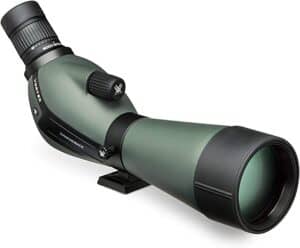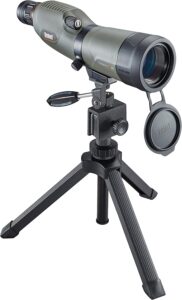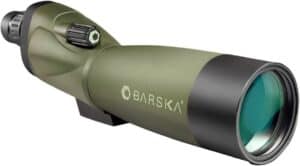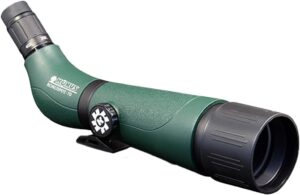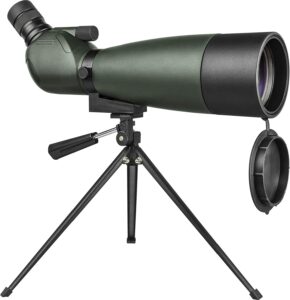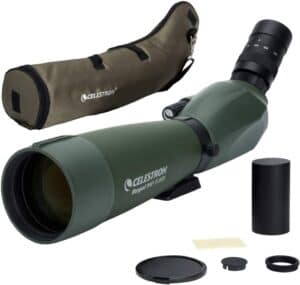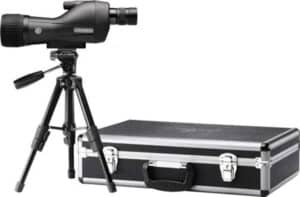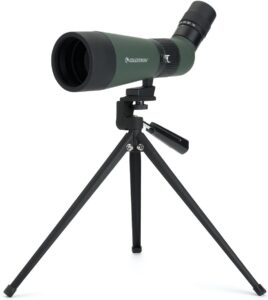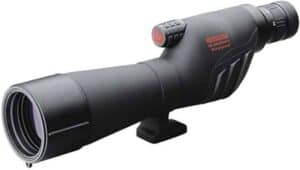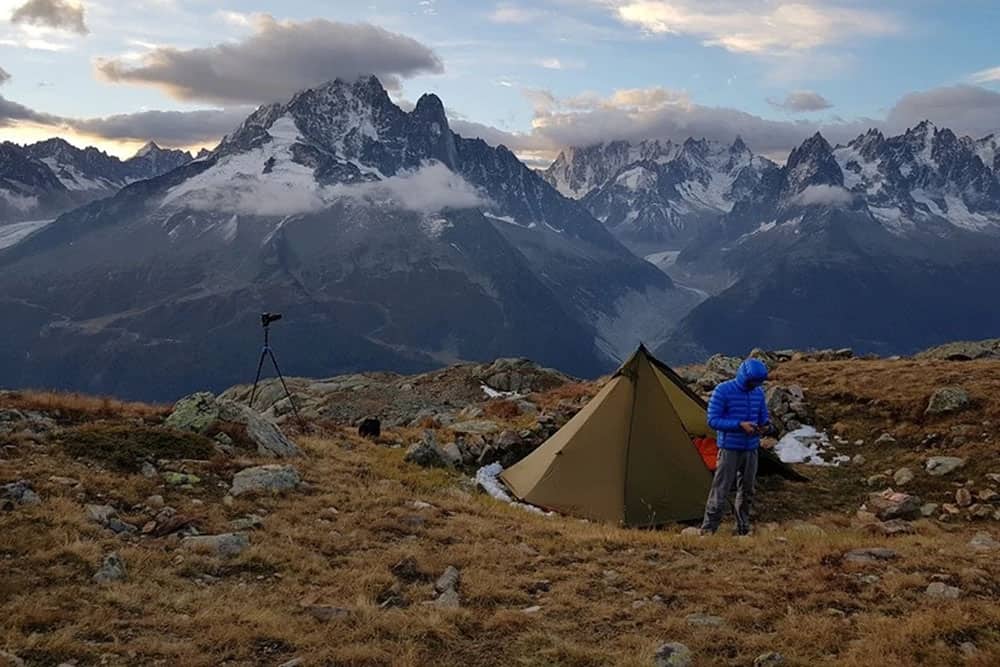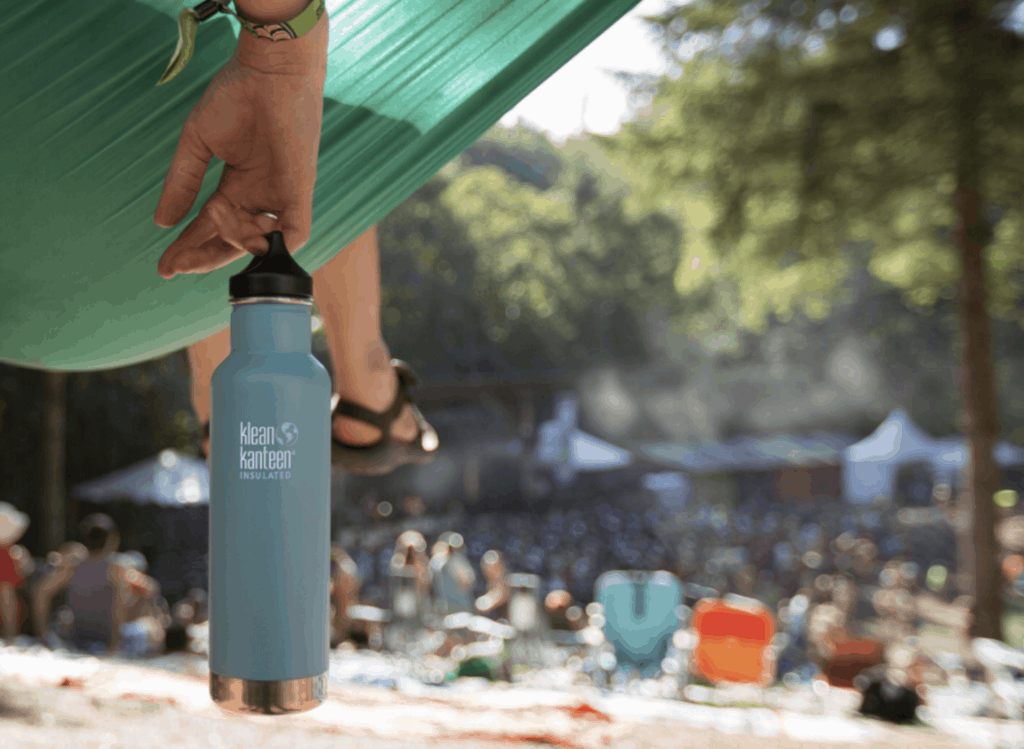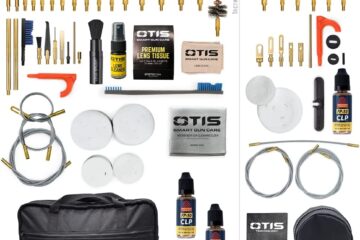A great spotting scope will give you much more magnification than a standard binocular can provide. Essentially, they are small telescopes that perform exceptionally well in full-light conditions. This makes them useful for a wide range of activities, including birding, hunting, surveillance, and viewing landscapes, wildlife, and other objects at a distance.
There are many spotting scopes to sort through and many are engineered for a very specific purpose. Our list of the 10 Best Spotting Scopes will help you narrow down the choices and find the scope that’s right for you. Also, be sure to read through our Buyer’s Guide for more info on selecting the perfect spotting scope.
1. Vortex Optics Diamondback
The Diamondback, by Vortex Optics, is a heavyweight in terms of performance, but it comes in a light, compact package. This spotting scope boasts fully multi-coated lenses that are combined with a retractable, built-in sunshade. This helps to promote excellent light transmission and guarantee the user a clear image.
This spotting scope also offers a twist-and-lock collar that allows you to move it to various glassing positions in order to maximize comfort. It also features a smooth focus wheel and a powerful zoom eyepiece, as well as rubber armor that enhances durability and helps to ensure a better grip.
2. Bushnell Trophy Xtreme
The Bushnell Trophy Xtreme is a uniquely portable, all-weather spotting scope that’s great for both birding and trophy hunting. It boasts a Porro-prism design with premium fully multi-coated optics and zoom magnification up to 60x.
This spotting scope also features a 100% waterproof, rubber armor construction and a 50-millimeter objective lens. It also comes with a compact tripod with window mount, a premium waterproof hard-side case, and a compact soft-side case.
3. Barska Blackhawk
The Barska Blackhawk is a waterproof spotting scope that sets a standard for portability, optical performance, and value. It is also 100% fog proof and is designed with shock-absorbing armor and a flare-reducing, extendable sunshade.
The Blackhawk also features a straight eyepiece, a multi-coated green lens with a tripod, and zoom magnification. Additionally, this spotting scope comes with both soft and hard carrying cases to protect it on any hunting or birding trip.
4. Konuspot 20
The innovative rainproof and fog proof design of the Konuspot 20 spotting scope makes it the perfect choice for hunters, birders, and other nature enthusiasts. Its versatile zoom power provides 60×70 magnification.
This spotting scope can offer a field of view of 118 feet at 20x magnification and 61.2 feet at 60x magnification. The Konuspot’s lens is 17.7 inches long and features an exit pupil length of 23.5 millimeters at 20x and 7.43 millimeters at 60x.
5. Orion Grandview 20
The Orion Grandview 20 is a great spotting scope for enjoying close-up views of birds, wildlife, scenic landscapes, and much more. It’s a versatile scope with a continuous zoom magnification range of 20 to 60x, which allows you to scan the horizon at 20x and take a closer look when needed.
This spotting scope offers a large, 80-millimeter aperture objective lens that gathers enough light to make every observation flush with detail. It can also focus on objects as close as 27 feet away and features a 45-degree angled eyepiece that’s great for comfortable daytime viewing.
6. Celestron Regal M2
The Celestron Regal M2 is highly touted as the next generation of Celestron’s top-performing Regal F-ED spotting scopes. It’s great for day and night use because it’s optimized to provide the sharpest image possible regardless of environmental conditions.
This spotting scope is great for bird watching, nature observing, long-distance viewing, and casual astronomical observing. It features extra-low dispersion glass, fully multi-coated optics, a magnesium alloy body, and a rotating tripod mount with detents.
7. Leupold SX-1 Ventana 2
The Leupold SX-1 Ventana 2 is another great spotting scope for a variety of outdoor activities, but this scope is best used by the experienced outdoors lover. It combines a sleek and superior industrial design with the best in optical quality for exceptional spotting.
This scope offers magnification power ranging from 20 to 60x and an objective lens diameter of 80 millimeters. It also features a rugged, armor-coated, waterproof design, a fully multi-coated lens, and eye relief ranging from 26.4 to 24 millimeters.
8. Pentax PF-80ED
The Pentax PF-80ED comes in a lightweight, magnesium alloy housing and it’s a great choice for anyone that’s looking for outstanding image quality and clarity under all light conditions. It offers a 45-degree slanted lens barrel for comfortable viewing.
This spotting scope incorporates extra-low dispersion glass elements for optimum optical resolution and a large, 80-millimeter objective lens for bright viewing. It also features a special “O” ring assembly that allows the body of the scope to be filled with nitrogen. This makes this spotting scope both fog proof and JIS Class 6 (1) waterproof.
9. Celestron Landscout 12
The Celestron Landscout 12 is an army green spotting scope that’s perfect to bring along on your next trip to the indoor or outdoor shooting range. It’s an easy-to-use scope that also provides value for a number of outdoor activities. This scope boasts fully coated optics that increases light transmission for bright, sharp images. It’s compact, lightweight, portable, and packable.
The scope’s rotating tripod mount allows you to place the orientation of the eyepiece in the best viewing position for application, and the adjustable magnification allows you to see a wide field of view for general viewing or a detailed close-up when needed.
10. Redfield Rampage
The Redfield Rampage 20-60×60 is the perfect spotting scope for times when you need more magnification in the field. It’s both portable and practical and it offers 60 x 60 magnification that gives you high-quality resolution when spotting distant targets.
This spotting scope is designed with a polycarbonate body that’s waterproof and features a retractable lens shade. Furthermore, the full scope kit comes with a lens cover, compact tripod, soft storage case, view-through soft case, and tripod adaptable mount.
—
Buyer’s Guide
Spotting scopes have been used for years for bird watching, naturalist activities, verifying marksman’s shots on a hunt, ranging, surveillance, and other applications that necessitate more magnification than a typical pair of binoculars can provide.
The first documented telescopic rifle sight was invented shortly after 1835 by Morgan James of Utica, New York (2). Today’s scopes come in a variety of shapes and sizes. To help you make the best decision possible, our Buyer’s Guide will focus on three major considerations: field of view, aperture, and focal length.
Field of View
A spotting scope’s field of view is defined as the widest dimension of circular viewing area observed through the lens. Most scopes will advertise their field of view in linear feet at 1000 yards, but some also use angular degrees. Typically, a scope’s field of view will decrease as you increase the magnification, but spotting scopes have a typical range of anywhere between one and three degrees.
A scope’s eyepiece design mostly determines its field of view. Some scopes are designed to give you a wide field of view using a wide-angle eyepiece. These are very popular and especially useful for following a moving object, as in birding or hunting.
In general, zoom eyepieces have a smaller field of view than an equivalent eyepiece with a fixed focal length. Buyers should also be aware that long eye relief eyepieces usually also have a narrower field of view.
Aperture
The aperture of a spotting scope is the diameter of the objective lens it contains. This diameter is usually measured in millimeters. For hunters, a good aperture size typically ranges from 50 to 90 millimeters.
Aperture size is directly related to the size and weight of the spotting scope, but the scope’s optical design and focal length also factor in. A larger objective lens will allow more light to enter the optical system, which increases image detail and clarity.
The final observed image brightness that you see when looking through a spotting scope is actually a product of several factors, which include the transmittance of the optical system (called “coatings”), the relationship of the aperture to the magnification (known as “exit pupil”), eye pupil size, and focal length of the objective lens.
Focal Length
Focal length is the distance between the main lens and the point where light rays from the image come sharply into view. The eyepiece of every spotting scope also has a focal length. The combination of these two focal lengths provides magnification of the image. Sometimes, the focal length can be called “focal ratio,” which refers to the ratio of the aperture diameter to the focal length of the objective lens.
Frequently Asked Questions
There can be a lot of technical information to digest when comparing and contrasting different spotting scopes. So, our Frequently Asked Questions will touch on some of the most common areas that people ask about when shopping for their new scope.
What is extra-low dispersion, or ED, glass?
Extra-low dispersion (also known as ED) glass helps to guarantee a sharper image and better colors when viewing through a scope. ED glass narrows and directs the wavelengths of light that enter the scope into a single focal point. By doing so, this glass eliminates chromatic aberrations to produce true-to-life colors.
What is the best type of eyepiece for hunting?
There are several types of eyepieces. Some have a fixed focal length and others have zoom magnification. Many hunters, however, prefer eyepieces with a straight-through design, which allows you to more easily sight an object and follow it as it moves.
What is the difference between a ‘refractor’ and a ‘catadioptric’?
The major difference between these two terms is the material that is used in their respective designs to focus the image. Refractor design uses optical glass lenses to bend light. Catadioptric design typically uses mirrors to reflect the light.
What is the difference between coated, multi-coated, and fully multi-coated optics?
Scopes come with a variety of lens designs. These terms relate to the number of layers of coating that’s applied to the glass surfaces of the lenses and the number of glass surfaces that the coating is applied to.
A coated lens will have at least one layer of coating applied to at least one of the glass surfaces. Multicoated scopes have multiple layers of coatings applied to at least one of the glass lenses. And finally, fully multi-coated scopes contain lenses with multiple layers of coating applied to all of them.
Can you explain ‘eye relief’?
Sure! Eye relief is the maximum distance your eyes can be from the lens while still being able to see the entire subject you’re looking at clearly, and not reducing the width of the image.
What do the numbers associated with spotting scopes mean?
Each scope is defined by two sets of numbers. For example, you might see a combination like “20-60×80’ after the scope’s brand name. The first set of numbers refers to the scope’s magnification or zoom. In this case, the scope would offer a magnification range from 20x to 60x. The second number refers to the diameter of the scope’s objective lens. In this case, the lens would be 80 millimeters in diameter.
Is it better to have an angled or straight spotting scope?
Most scopes feature either a straight or angular eyepiece. There are advantages and disadvantages to both. With a straight scope, it’s generally easier to use for hunting purposes, where you might be lying flat on the ground to conceal your position.
For many other applications, however, angled spotting scopes are easier to use for an extended period of time, they’re more convenient to share with other viewers, they allow you to aim skyward with less effort, and it’s easier to attach and use a camera with an angled spotting scope.
Summary
Whether you’re a serious bird watcher, casual nature observer, or hardcore big game hunter, there’s a spotting scope out there for you. We hope that you’ve found the information in this article useful and we wish you the best of luck in selecting your next spotting scope.
